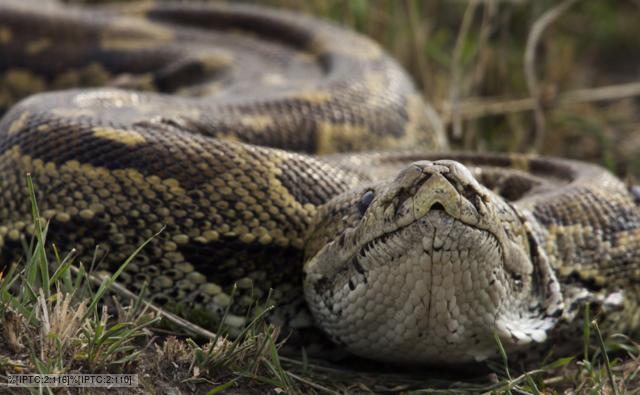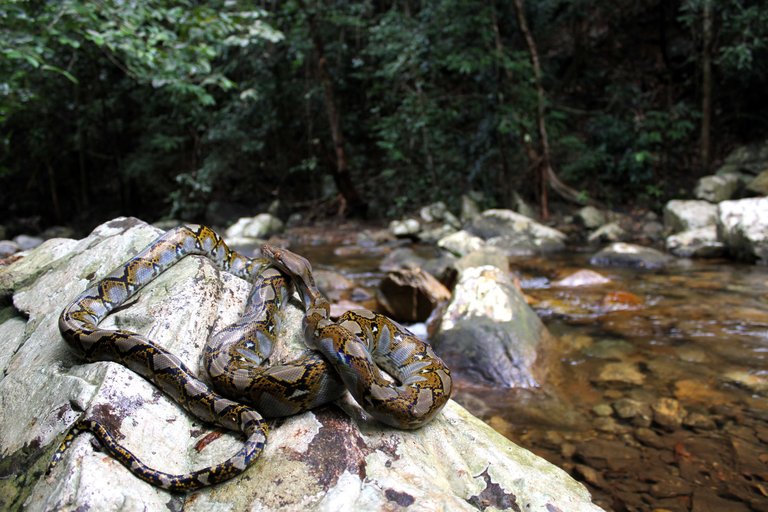Popular pythons form superfamilly Pythonidea and they are represent by 43 species (but expect more in future). Inside this superfamilly we have three families. First the most basal from them are Xenopeltidae (south-east Asian sunbeam snakes), Loxocemidae (Mexican Burrowin pythons) and of course Pythonidae. You are probably know that pythons are live in old world (Asia, Australia, Europe, Africa) and s-e Asian sunbeam snakes so what Mexican burrowing pythons doing in middle America. This is related with continental drift. Pythons evolved in Gondwanaland where all continents stick together. When continents start to divide some groups of animals are isolated on this swimming masses of land. Some of them menage to survive and this is the most probable scenario of distant living location of Mexican burrowing pythons.
But back to topic. In newest research the most basal group (not primitive but they are more old in philogenetically terms than other pythons) are genus Python. Inside this genus we find for example African rock python and the most basal of all pythons Python regius probably the most widely breeded snake and better known under ball python name.
African rock python (P. sebae) from www.bbc.co.uk/nature/life/Python_sebae
We know that genus Python had heave inside a intruder, a reticulated python. Now reticulated python along with Timor python are form different taxa - Malayopython. In wide range of websites (wikipedia for example) they are still named as Python reticulatus or Python timorensis where they should be called Malayopython reticulatus and M. timorensis. However it is possible that in future genus Malayopython will have more species than those two.Why scientist wanted to divide this genus? Because reticulated python are more similar to Australian group of pythons instead of African and Asian mainland genus Python. Not that long ago reticulated python weren't in genus Python nor Malayopython but in Broghammerus. However the name Broghammerus was use against taxonomical law by R. Hoser. Mr Hoser have ability to be really problematic for taxonomists but abut that I say more another time. To help you move in this cclassificational dimension I share with you phylograme of pythons ( from Reynolds et al., 2014).
Reticulated python (M. reticulatus) from http://calphotos.berkeley.edu/
As you can see below on the top are most basal species and on bottom are the most advanced Australian species. Following those lines from left you can see that they are always divided on two. This way you can check what species are the closest relatives to another.
Phylogeny of pythons and their distribution from Rawlings et al. 2014
In Australian pythons group we can see even more changes. Genus Morelia have been divided in two different groups. One group is carpet/tree pythons group and second one is group of amethystine/scrub pythons. All carpet and tree pythons are stay in genus Morelia but all amethystine pythons are move to genus Simalia. For example amethystine python are no longer Morelia amethystina but Simalia amethistina. In genus Simalia are a lot of new species thankfully for work of (Schleip, 2008). In green tree python (Morelia viridis) populary named chondro (from their older name Chondropython). This is great that in future we could have two green tree python species Morelia viridis and Morelia azurea what I find very exciting. Also in carpet pythons it is possible that there are other species but there is needed more research.
Moluccan python (S. clastolepis) from moreliapythonradio.com
As you can see on phylogramme above the sister genus to Morelia (closest relatives) are Antaresia who is popularly known as Children's pythons. Inside this genus I didn't notice any changes so lets move on.
Next genus Liasis have some surprises for us. The olive python are no longer in their own genus Apodora but in Liasis. Liasis papuanus (olive python) could have cryptic species (not currently described).
Olive python (L. olivaceus) from gondwanareptilesproductions.com
Genus Aspidites was prefiously taken by the most basal genus of all pythons (because they lack of thermal pits). However along with molecular data their status turn out to be one of the most advanced of all pythons. In genus Aspidites we can find small pythons dwelling on the ground and eating lizards and that's the reason why they lost thermal pits. Lizards are coldblooded (exothermic) so they have temperature as surroundings. In that way thermal pits were useless. They adapted to their prey and lost their thermoreceptic organ. Although pythons along with boas and vipers are known for having thermoreceptic organ the most important of all senses in snakes are chemoreceptive organ. That one which involved uses of divided tongue.
The last genus of pythons is Bothrochilus. This genus where old times was only Bothrochilus boa (Bismarck python) was merged with Leiopython. In this case Leiopython (D'alberts water pythons) are not longer exist and all old Leiopython species are now in Bothrochilus. In this genus we can also notice that there are no longer so few species. Instead of three species we can find there even seven species!
White - lipped python (B. alberisii) from http://www.natureswindow.dk/
where by the way he is still described as Leiopython.
I know that topic could be a little bit hard to follow and not all of you will enjoy reading it as I writing. Nevertheless I'm hoping that you will learn some new things and be at least surprised for those changes. And as you can see there is a lot of news in pythons.
Look forward to new posts because next time I will write about classification of boas!
If you will have any questions feel free to ask me below.
Interesting literature:
- Noonan, B.P., Chippindale, P.T., 2006a. Dispersal and vicariance: the complex evolutionary history of boid snakes. Molecular Phylogenetic Evolution 40, 347–58. doi:10.1016/j.ympev.2006.03.010
- O’Shea, M., 2011. Boas & Pythons of the World. New Holland Publishers Ltd, London.
- Pyron, R.A., Burbrink, F.T., Wiens, J.J., 2013. A phylogeny and revised classification of Squamata, including 4161 species of lizards and snakes. BMC Evolutionary Biology 13, 93. doi:10.1186/1471-2148-13-93
- Rawlings, L.H., Barker, D., Donnellan, S.C., 2004. Phylogenetic relationships of the Australo-Papuan Liasis pythons (Reptilia : Macrostomata), based on mitochondrial DNA. Australian Journal of the Zoology. 52, 215–227.
- Rawlings, L.H., Donnellan, S.C., 2003. Phylogeographic analysis of the green python, Morelia viridis, reveals cryptic diversity. Molecular Phylogenetic Evolution. 27, 36–44. doi:10.1016/S1055-7903(02)00396-2
- Rawlings, L.H., Rabosky, D.L., Donnellan, S.C., Hutchinson, M.N., 2008. Python phylogenetics: inference from morphology and mitochondrial DNA. Biological Journal of the Linnean Society. 93, 603–619.
- Reynolds, R.G., Niemiller, M.L., Revell, L.J., 2014. Toward a Tree-of-Life for the boas and pythons: Multilocus species-level phylogeny with unprecedented taxon sampling. Molecular Phylogenetic Evolution 71, 201–213. doi:10.1016/j.ympev.2013.11.011
- Schleip, W., O’Shea, M., 2010. Annotated checklist of the recent and extinct pythons (Serpentes, Pythonidae), with notes on nomenclature, taxonomy, and distribution. ZooKeys 66. doi:10.3897/zookeys.66.683
- Schleip, W.D., 2008. Revision of the Genus Leiopython Hubrecht 1879 (Serpentes: Pythonidae) with the Redescription of Taxa Recently Described by Hoser (2000) and the Description of New Species. Journal of Herpetology. 42, 645–667. doi:10.1670/06-182R5.1
- Wiens, J.J., Hutter, C.R., Mulcahy, D.G., Noonan, B.P., Townsend, T.M., Sites, J.W., Reeder, T.W., 2012. Resolving the phylogeny of lizards and snakes (Squamata) with extensive sampling of genes and species. Biology Letters 8, 1043–1046. doi:10.1098/rsbl.2012.0703







No comments:
Post a Comment